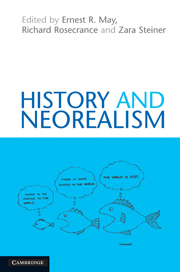Book contents
- Frontmatter
- Contents
- List of tables
- Notes on contributors
- Acknowledgments
- 1 Theory and international history
- 2 Transformations in power
- 3 Domestically driven deviations: internal regimes, leaders, and realism's power line
- 4 How international institutions affect outcomes
- 5 Not even for the seventeenth and eighteenth centuries: power and order in the early modern era
- 6 Austria-Hungary and the coming of the First World War
- 7 British decisions for peace and war 1938–1939: the rise and fall of realism
- 8 Realism and risk in 1938: German foreign policy and the Munich Crisis
- 9 Domestic politics, interservice impasse, and Japan's decisions for war
- 10 Military audacity: Mao Zedong, Liu Shaoqi, and China's adventure in Korea
- 11 The United States' underuse of military power
- 12 The overuse of American power
- 13 Redrawing the Soviet power line: Gorbachev and the end of the Cold War
- 14 Shared sovereignty in the European Union: Germany's economic governance
- 15 John Mearsheimer's “elementary geometry of power”: Euclidean moment or an intellectual blind alley?
- 16 History and neorealism reconsidered
- Index
- References
7 - British decisions for peace and war 1938–1939: the rise and fall of realism
Published online by Cambridge University Press: 05 June 2012
- Frontmatter
- Contents
- List of tables
- Notes on contributors
- Acknowledgments
- 1 Theory and international history
- 2 Transformations in power
- 3 Domestically driven deviations: internal regimes, leaders, and realism's power line
- 4 How international institutions affect outcomes
- 5 Not even for the seventeenth and eighteenth centuries: power and order in the early modern era
- 6 Austria-Hungary and the coming of the First World War
- 7 British decisions for peace and war 1938–1939: the rise and fall of realism
- 8 Realism and risk in 1938: German foreign policy and the Munich Crisis
- 9 Domestic politics, interservice impasse, and Japan's decisions for war
- 10 Military audacity: Mao Zedong, Liu Shaoqi, and China's adventure in Korea
- 11 The United States' underuse of military power
- 12 The overuse of American power
- 13 Redrawing the Soviet power line: Gorbachev and the end of the Cold War
- 14 Shared sovereignty in the European Union: Germany's economic governance
- 15 John Mearsheimer's “elementary geometry of power”: Euclidean moment or an intellectual blind alley?
- 16 History and neorealism reconsidered
- Index
- References
Summary
For many years, the dominant approach to the study of international relations has been that of structural realism. Because this theory has such a long pedigree, there is a great divergence of views among those who call themselves or are called “realists” or “neorealists.” In order to give shape to this chapter, I have arbitrarily selected what I consider to be the main features of the realist case, knowing that many variants of the model exist. Realists begin with the assumption that states live in an anarchical international environment where there is no authority above that of the state. As a result, great powers, usually the focus of realist theorists, must rely on “self-help” to survive. They seek to maximize their power as against other states, though occasionally they will try to achieve absolute power without regard to the other players in the system. States which try to increase their power necessarily make other states feel more insecure and they will respond by adopting strategies to enhance their chances of survival. Structural realists or defensive realists, following Kenneth Waltz, argue that when great powers act aggressively, their would-be victims try to balance against the aggressor and check its threat to their survival. The anarchical conditions of the international life encourage states to behave defensively so that they can protect themselves and try to maintain their power positions.
- Type
- Chapter
- Information
- History and Neorealism , pp. 129 - 154Publisher: Cambridge University PressPrint publication year: 2010
References
- 1
- Cited by



